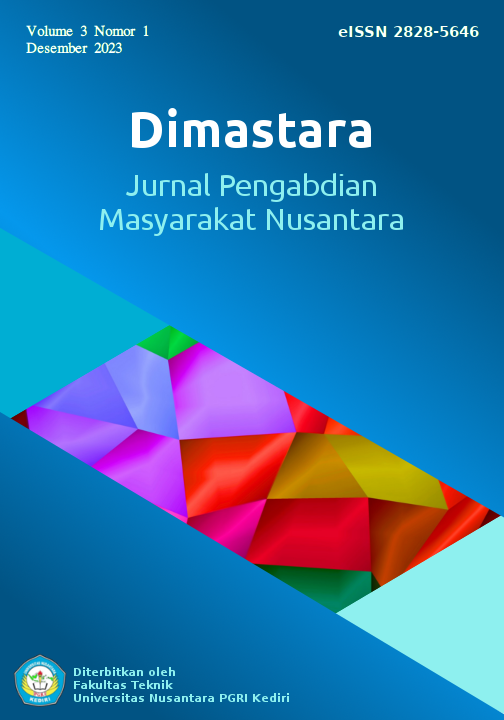Penyuluhan Dan Skrining Kesehatan Sebagai Upaya Pencegahan PTM Pada Anggota DWP UPT PSDA WS Brantas Kediri
DOI:
https://doi.org/10.29407/dimastara.v3i1.21600Keywords:
Counseling, health screening, PTMAbstract
Currently, the community, especially members of DWP UPT PSDA WS Brantas Kediri are facing an epidemic challenge againt non-communicable diseases, where the main risk factor is an unhealthy lifestyle. PTM which has the highest prevalence in DWP UPT PSDAWS Brantas Kediri namely hypertension, diabetes millitus, high uric acid and cholesterol, all of which cause strokes. Counseling and health screening are the initial stages of assessment for interventions against PTM risk factors. This PKM aims to conduct counseling and health screening to DWP UPT PSDA WS Brantas Kediri about the dangers and prevention of PTM. The implementation of this PKM is divided into two parts, namely health counseling and health screening and the number of members who take part in this activity is 80 person. The results of counseling and health screening that are most at risk of becoming NCDs are cholesterol as much as 17,1%; not exercising regularly 49%; history of stroke in the family as much as 11,3%; besides high blood pressure as much as 13,7%. This health counseling and screening provides health education and prevention efforts against deadly PTM, so it is very important to do this regularly with cross-sector collaboration to support the government in reducing the risk and increasing the prevalence of PTM.
Downloads
References
[2] Calcaterra, V., & Zuccotti, G. (2022). Non-Communicable Diseases and Rare Diseases: A Current and Future Public Health Challenge within Pediatrics. Children, 9(10), 9–11. https://doi.org/10.3390/children9101491
[3] Endarti, A. T., & Handito, A. (2016). The Relationship between Non-communicable Disease History. Jurnal Kesehatan Masyarakat, 12(23), 120–130.
[4] Hedayatnia, M., Asadi, Z., Zare-Feyzabadi, R., Yaghooti-Khorasani, M., Ghazizadeh, H., Ghaffarian-Zirak, R., Nosrati-Tirkani, A., Mohammadi-Bajgiran, [1] Booth, F. W., Roberts, C. K., Thyfault, J. P., Ruegsegger, G. N., & Toedebusch, R. G. (2017). Role of inactivity in chronic diseases: Evolutionary insight and pathophysiological mechanisms. Physiological Reviews, 97(4), 1351–1402. https://doi.org/10.1152/physrev.00019.2016
[2] Calcaterra, V., & Zuccotti, G. (2022). Non-Communicable Diseases and Rare Diseases: A Current and Future Public Health Challenge within Pediatrics. Children, 9(10), 9–11. https://doi.org/10.3390/children9101491
[3] Endarti, A. T., & Handito, A. (2016). The Relationship between Non-communicable Disease History. Jurnal Kesehatan Masyarakat, 12(23), 120–130.
[4] Hedayatnia, M., Asadi, Z., Zare-Feyzabadi, R., Yaghooti-Khorasani, M., Ghazizadeh, H., Ghaffarian-Zirak, R., Nosrati-Tirkani, A., Mohammadi-Bajgiran, M., Rohban, M., Sadabadi, F., Rahimi, H. R., Ghalandari, M., Ghaffari, M. S., Yousefi, A., Pouresmaeili, E., Besharatlou, M. R., Moohebati, M., Ferns, G. A., Esmaily, H., & Ghayour-Mobarhan, M. (2020). Dyslipidemia and cardiovascular disease risk among the MASHAD study population. Lipids in Health and Disease, 19(1), 1–11. https://doi.org/10.1186/s12944-020-01204-y
[5] Hou, X., Anderson, I., & Burton-Mckenzie, E. J. (2017). Health and noncommunicable diseases: bending the noncommunicable diseases cost curve in the Pacific. 5, 1–37. https://elibrary.worldbank.org/doi/pdf/10.1596/28136
[6] Oparil, S., Acelajado, M. C., Bakris, G. L., Berlowitz, D. R., Cífková, R., Dominiczak, A. F., Grassi, G., Jordan, J., Poulter, N. R., Rodgers, A., & Whelton, P. K. (2018). Hypertension. Nature Reviews Disease Primers, 4. https://doi.org/10.1038/nrdp.2018.14
[7] Ragab, G., Elshahaly, M., & Bardin, T. (2017). Gout: An old disease in new perspective – A review. Journal of Advanced Research, 8(5), 495–511. https://doi.org/10.1016/j.jare.2017.04.008
[8] Rarau, P., Guo, S., Baptista, S. N., Pulford, J., McPake, B., & Oldenburg, B. (2020). Prevalence of non-communicable diseases and their risk factors in Papua New Guinea: A systematic review. SAGE Open Medicine, 8. https://doi.org/10.1177/2050312120973842
[9] Sagan, A., Mcdaid, D., Rajan, S., Farrington, J., & Mckee, M. (2020). Screening and how can we get it right ? 1–24.
[10] Salsabila, Z., & Sjaaf, A. C. (2022). the Analysis of Diabetes Self-Management Implementation on Type 2 Diabetes Mellitus Patients: a Protocol for Systematic Review and Meta-Analysis. Jurnal Ekonomi Kesehatan Indonesia, 7(2), 133. https://doi.org/10.7454/eki.v7i2.6100
Downloads
Published
Issue
Section
License
Penulis yang menerbitkan jurnal ini menyetujui persyaratan berikut:
- Hak cipta atas artikel apa pun dipegang oleh penulisnya.
- Penulis memberikan jurnal, hak publikasi pertama dengan karya yang dilisensikan secara bersamaan di bawah Lisensi Atribusi Creative Commons yang memungkinkan orang lain untuk membagikan karya dengan pengakuan atas kepenulisan dan publikasi awal karya tersebut dalam jurnal ini.
- Penulis dapat membuat pengaturan kontrak tambahan yang terpisah untuk distribusi non-eksklusif dari versi jurnal yang diterbitkan dari karya tersebut (misalnya, mempostingnya ke repositori institusional atau menerbitkannya dalam sebuah buku), dengan pengakuan dari publikasi awalnya di jurnal ini.
- Penulis diizinkan dan didorong untuk memposting karya mereka secara online (misalnya, di repositori institusional atau di situs web mereka) sebelum dan selama proses pengiriman, karena hal itu dapat mengarah pada pertukaran yang produktif, serta kutipan yang lebih awal dan lebih besar dari karya yang diterbitkan.
- Artikel dan materi terkait yang diterbitkan didistribusikan di bawah Lisensi Internasional Creative Commons Attribution-ShareAlike 4.0













